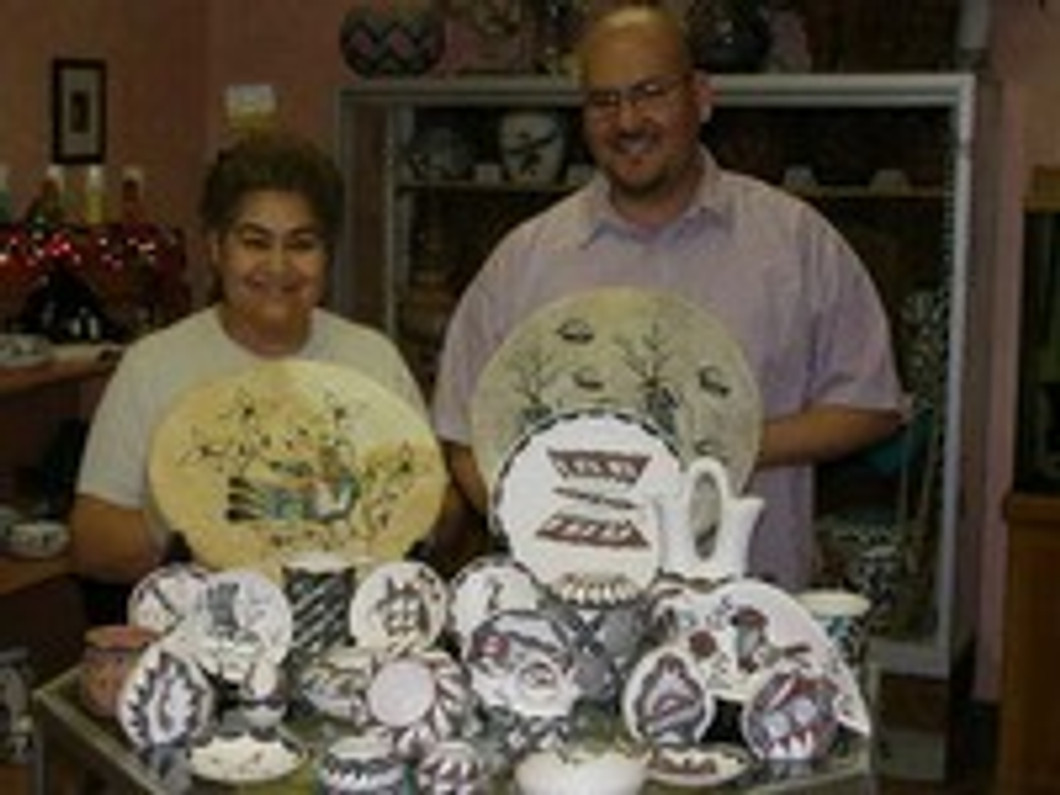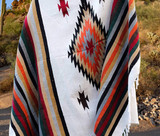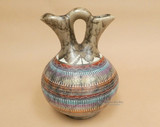Tigua Indian Pottery & Drum Painting
Ysleta Del Sur Pueblo-Tigua Indian Pottery is becoming very rare with only two artists remaining who continue the traditional painted pottery which is created without pencil lines or templates. Their traditional weavings have already ceased as the modern Tigua are influenced by outside cultures. If you have an opportunity to own a piece of authentic Native American Tigua pottery you are in good company with collectors of pueblo pottery who include both President’s Bush and Clinton as well as many other dignitaries. Who Are the Tigua Indians? The Tigua Indians are one of the Puebloan tribes and the only one located in Texas. The Pueblo Indians are made up of 22 tribes still in existence in the southwest, twenty in New Mexico and one in Arizona as well as the Tigua or Ysleta Del Sur located just east of El Paso, TX. About 50 earlier Pueblo tribes are now extinct. All the Puebloan tribes had similar ways of life but different languages and so were grouped under the title of Pueblo Indians. Their name, Pueblo, coming from the Spanish meaning village is a reference to how they lived in Pueblos, an image now synonymous with southwest decor.
Acoma pueblo is the oldest continually inhabited village in the southwest. One of the largest of the original pueblos was Gran Quivera, started about 800 AD, located south of present day Albuquerque. From here the Isleta tribe, who spoke Tiwa migrated south to their present El Paso location as a result of 1680 Pueblo revolt. They named their new pueblo Ysleta Del Sur where they speak Tigua. As such the Tigua Indians are a part of a rich culture who still survive and preserve their National heritage through traditional ceremonies and handcrafts. The Tigua Indians were thought by some to be extinct in the 1930’s. But tribal leaders began to rally the people and to express themselves as a people, laying claim to the land they had lost as a result of their land grant from Spain not being honored. As late as 1968 the State of Texas finally officially recognized the Tigua as a tribe and President Lyndon Johnson also recognized the Tigua as a Nation by signing an act of congress which made their remaining land a reservation. Today, the Tigua still live on their land. Who Are The Tigua Artists?
We are always looking for ways to help Indigenous people as we have from the beginning with the Tarahumara Indians. We had the pleasure of meeting Albert Alvidrez, the former Governor of the Tigua tribe by introduction by an aquanitance in El Paso, TX. Albert is a registered member of the Ysleta Del Sur Pueblo-Tigua Indian Reservation and served as Governor for nine consecutive terms. Albert is also one of only two remaining Tigua potters, his Mother Yolanda being the second. Both Albert and Yolanda are warm and friendly people with a desire to see their people’s heritage continued. Similar in style to Mata Ortiz pottery, Tigua pottery will be lost if not preserved. During a visit to speak with Albert about Mission Del Rey helping make their pottery available, we also had a chance to participate in one of the tribes traditional dances. It gave us a personal appreciation for the culture and a desire to share their rich heritage with others. We will be helping advance the Tigua pottery craft and it is a real honor to be able to help continue such an ancient art. We feel a deep sense of responsibility in helping to preserve it for future generations.
With your help we can raise awareness and would like to see a revival of the traditional crafts among the younger members of the tribe, but for now Albert and Yolanda are the only remaining potters of the historic Tigua Indians. "It is important for tribal communities to preserve their traditional crafts and cultural practices. In this modern world we live in, one must hold on to our unique identity and heritage. Our tribal communities have struggled for many generations, and our forefathers and their forefathers, fought to preserve our heritage, it is important that we not let it die. Our works of art are beautiful, religious and spiritual expressions that will heal and bring communities of various origins together.
Recent Posts
-
Southwestern Blankets - The Must-Have Summer Staple
Southwest style has been around for years, but has lately been given new life through the popular bo …May 23rd 2022 -
Shop Wedding Vases For The Special Couple
With wedding season just around the corner, chances are you'll be attending the union of two happy p …May 13th 2022 -
Fantastic Beach Finds For Less
As we head into the summer months, you're probably dreaming of lazy days spent on the beach soaking …May 7th 2022





